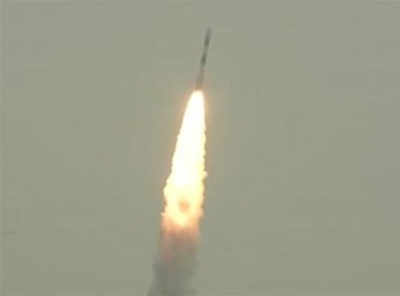- News
- India News
- Isro’s PSLV-C35 places SCATSAT-1, seven other satellites in orbit in longest ever launch mission
Trending
This story is from September 26, 2016
Isro’s PSLV-C35 places SCATSAT-1, seven other satellites in orbit in longest ever launch mission
Indian Space Research Organisation on Monday successfully placed advanced weather satellite SCATSAT-1 and seven other satellites in orbits in its longest ever launch mission, which spanned over two hours and 15 minutes.

PSLV-C35 carrying SCATSAT-1 and seven other satellites takes off from Satish Dhawan Space Centre in Sriharikota on Monday (TOI pic by Ramesh Shankar)
SRIHARIKOTA: Indian Space Research Organisation on Monday successfully placed advanced weather satellite SCATSAT-1 and seven other satellites in orbits in its longest ever launch mission, which spanned over two hours and 15 minutes.
It is for the first time that satellites were placed in two different orbits with a single rocket. Vikram Sarabhai Space Centre director K Sivan said, “The rocket has placed all the satellites in precise orbits.”
The Polar Satellite Launch Vehicle (PSLV-C35) carrying the eight satellites took off from Satish Dhawan Space Centre in Sriharikota at 9.12am.Around 17 minutes later, SCATSAT-1, the main payload of PSLV in its 37th flight, was placed in the polar sun synchronous orbit at an altitude of about 730km.
SCATSAT-1, which will provide weather forecast including cyclone detection and tracking, will succeed the now defunct Oceansat-2 satellite launched in 2009. Isro chairman A S Kiran Kumar said SCATSAT-1 would be a stop gap arrangement between Oceansat-1 and Oceansat-2.
Again, after an hour, the engine was restarted and cut off within a period of about one minute for it to further coast. It then began injecting the rest of the satellites. They included two satellites developed by educational institutions -- Pratham from IIT-Bombay and Pisat from PES University, Bangalore, and its consortium -- and five other commercial satellites from Algeria, Canada and the US.
Mission director B Jayakumar said, "The mission had many complexities - planning and execution, power management and thermal management. PSLV now has the flexibility to suit customer demands."
The challenge in the launch was igniting and shutting down the fourth-stage engine, called multiple burn technology, twice within a short span of time in a cold and low-gravity environment and letting it coast further. Isro demonstrated the technology in its two previous PSLV launches – PSLV-C34 in June 2016 and PSLV-C29 in December 2015. But the trickiest part was to cool down the engine between two restarts and protect the rocket and satellites from the heat generated when the engine is operational.
Mastering the technology meant that Isro can accommodate satellites meant for different orbits in a single rocket thereby saving costs. Earlier, they had to build separate rockets to be flown to different orbits. It would cost around Rs 120 crore on an average to build a PSLV.
Placing satellites in different orbits will also facilitate launching more such commercial satellites in the future.
Kiran Kumar said assembling of various stages for GSLV Mark III began on Sunday. "We are gearing up for the launch at the earliest." GSAT18 would be launched on October 4 from French Guiana, he added.
It is for the first time that satellites were placed in two different orbits with a single rocket. Vikram Sarabhai Space Centre director K Sivan said, “The rocket has placed all the satellites in precise orbits.”
The Polar Satellite Launch Vehicle (PSLV-C35) carrying the eight satellites took off from Satish Dhawan Space Centre in Sriharikota at 9.12am.Around 17 minutes later, SCATSAT-1, the main payload of PSLV in its 37th flight, was placed in the polar sun synchronous orbit at an altitude of about 730km.
SCATSAT-1, which will provide weather forecast including cyclone detection and tracking, will succeed the now defunct Oceansat-2 satellite launched in 2009. Isro chairman A S Kiran Kumar said SCATSAT-1 would be a stop gap arrangement between Oceansat-1 and Oceansat-2.
After the first satellite injection, PSLV-C35 coasted for an hour before its fourth-stage engine was reignited and shut down, for about 20 seconds. This provided the rocket the necessary thrust to coast into the polar orbit at an altitude of 689km.
Again, after an hour, the engine was restarted and cut off within a period of about one minute for it to further coast. It then began injecting the rest of the satellites. They included two satellites developed by educational institutions -- Pratham from IIT-Bombay and Pisat from PES University, Bangalore, and its consortium -- and five other commercial satellites from Algeria, Canada and the US.
Mission director B Jayakumar said, "The mission had many complexities - planning and execution, power management and thermal management. PSLV now has the flexibility to suit customer demands."
The challenge in the launch was igniting and shutting down the fourth-stage engine, called multiple burn technology, twice within a short span of time in a cold and low-gravity environment and letting it coast further. Isro demonstrated the technology in its two previous PSLV launches – PSLV-C34 in June 2016 and PSLV-C29 in December 2015. But the trickiest part was to cool down the engine between two restarts and protect the rocket and satellites from the heat generated when the engine is operational.
Mastering the technology meant that Isro can accommodate satellites meant for different orbits in a single rocket thereby saving costs. Earlier, they had to build separate rockets to be flown to different orbits. It would cost around Rs 120 crore on an average to build a PSLV.
Placing satellites in different orbits will also facilitate launching more such commercial satellites in the future.
Kiran Kumar said assembling of various stages for GSLV Mark III began on Sunday. "We are gearing up for the launch at the earliest." GSAT18 would be launched on October 4 from French Guiana, he added.
End of Article
FOLLOW US ON SOCIAL MEDIA










